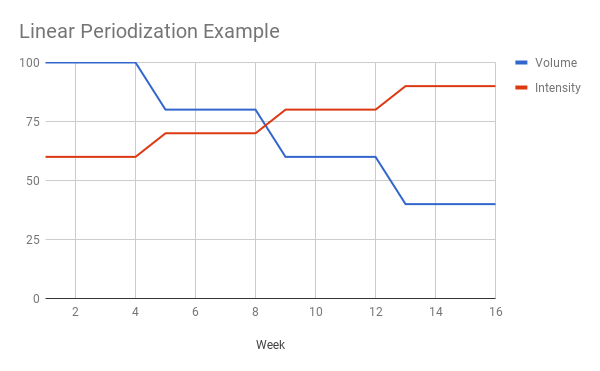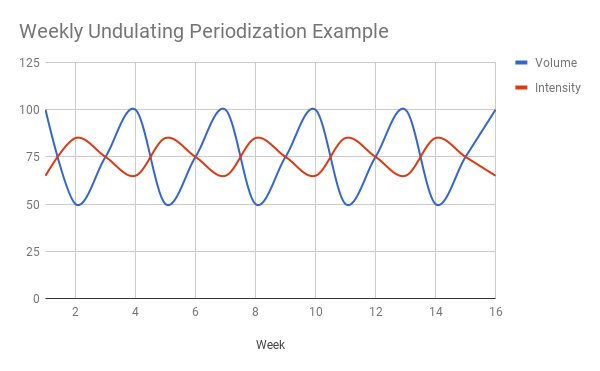The holy grail of incredible results meets at the intersection of personalized recommendations, proven techniques, and consistency. Without those variables, you’re unlikely to dramatically transform your body.
But, there’s one other variable that’s required, which is most often misunderstood or incorrectly applied: adaptation.
Shredding fat and building muscle is a byproduct of adaptation—but too much adaptation means you won’t change. It’s about working that thin line between challenging your body and burning them out. Between getting stronger and plateauing.
The best trainers find that line by using periodization: systematically programming workout routines over the long term through a variety of daily, weekly, monthly, and yearly cycles.
“If we run the same program on you year-in and year-out, you won’t progress. You’ll actually get worse,” explains Minnesota-based exercise physiologist Mike T. Nelson, Ph.D., C.S.C.S.
“Instead, looking over the mesocycle [a larger chunk of time, which typically runs for about a month, made up of smaller microcycles], you should see your clients progressing while lowering their rate of perceived exertion. You have to help them disturb the body from homeostasis, but allow it to recover through appropriate manipulation of the General Adaptation Syndrome [GAS].”
GAS is informational fuel for trainers: Broken down into the alarm, resistance, and exhaustion phases, it describes your body’s reaction to stress. For optimum results, workouts must shock your body (the alarm stage) and allow it to adapt to become stronger (resistance) without overtraining (exhaustion).
Let’s dive into the two main periodization models—linear and undulating—and how to put them together so that you can identify the type of plan that might best help you crush your goals.
Table of Contents
Linear Periodization: Simple to Follow, Tried and True

The original form of periodization, linear progressions started as a method to get high-level athletes ready for competition, explains Nick Tumminello, C.P.T., owner of Performance University in Fort Lauderdale.
“Trainers asked, ‘What does their performance need to look like for competition?’ And then they worked backward. In its purest form, that’s what periodization comes from.”
When programming linear plans, trainers manipulate intensity or load while keeping sets and reps relatively constant. For instance, a trainer may instruct a client to perform three sets of 10 bench press reps once per week for a month or two, going up in weight when able.
A trainer may also have a client perform those same bench press reps three days per week, lifting with a heavy load on the first day, medium on the second, and light on the third, Tumminello says.
However, as linear plans originated as a way to prepare athletes for competition, they typically progress throughout the year from muscular endurance- and hypertrophy-based schemes to prioritize max strength and power. Intensity increases and volume decreases every few weeks or months.
Undulating Periodization: Keeping the Body Guessing

Spin-offs of linear periodization models, undulating schemes are based on the theory that linear models do not include enough variations, or undulations, in workload to spur optimum adaptations, Tumminello says.
So rather than only varying loads, they also switch up sets and reps throughout the microcycle, usually on a daily basis.
For instance, you may perform a strength workout on one day, a hypertrophy (muscle-building) workout on the second, and a muscular endurance-based workout on the third.
“Everything that goes into each day is associated with one adaptation,” Nelson says. “Through the course of the week, you promote a wide range of adaptations.”
The Best Periodization Model for You
No single periodization plan is best for everyone. Rather, the right model for every p comes down to:
- your personality
- specificity of your goals
If you’re trying to get healthier, lose some excess weight, or gain functional strength, the ultimate goal is adherence.
After all, according to a 2015 Journal of Strength & Conditioning Research meta-analysis of 17 prior studies, both linear and undulating methods result in similar increases in upper- and lower-body muscle strength.
So, which one will you want to stick with?
If you’re somewhat new to training (less than 2 years of consistent workouts), it’s usually helpful to see progress to help keep you on track and motivated. If this applies to you, then a linear plan might be best.
Linear training models can also be the easiest to follow if you aren’t meeting with a trainer or have an accountability system.
Alternatively, if you get bored easily with your workouts, undulating models can feel more interesting.
If you have more than 2 years of consistent weight training or competitive goals, you’re more likely to benefit from undulating plans that integrate high, medium, and low loads and rep schemes.
For example, while a 2016 study from CUNY Lehman College found that undulating could potentially lead to superior upper-body increases in strength and muscle growth, and an International Journal of Sports Medicine study found that undulating plans enjoyed better developments in muscular endurance.
“Understand what parameters you are trying to improve and focus on those,” Nelson says.
To do that, it’s often helpful to think of both linear and undulating plans as options at different times. For instance, Tumminello often has more advanced clients follow a linear model in a few “benchmark moves” like a squat, deadlift, bench press, or rows, and, then, perform assistance exercises (think isolates moves like biceps curls) with an undulating scheme.
Every four to six weeks, the program, including benchmark moves, changes. FYI, in the Journal of Strength & Conditioning Research meta-analysis, study authors emphasized that no matter the periodization plan, varying the workout every two to six weeks is ideal for maximum effectiveness.
That said, things don’t have to be complicated, and it’s important not to over-plan your workouts. If you’re training consistently, working hard, and improving how much weight you lift, reps you perform, sets completed, or become more efficient with your rest periods (or all of the above) — that’s when you know you’re on the right track and will see results.
READ MORE
Deconstructing The “Best” Workout Plan
How Often Should I Change Reps?
Are You Really Overtraining? (Or Just A Little Sore?)

Adam Bornstein is a New York Times bestselling author and the author of You Can’t Screw This Up. He is the founder of Born Fitness, and the co-founder of Arnold’s Pump Club (with Arnold Schwarzenegger) and Pen Name Consulting. An award-winning writer and editor, Bornstein was previously the Chief Nutrition Officer for Ladder, the Fitness and Nutrition editor for Men’s Health, Editorial Director at LIVESTRONG.com, and a columnist for SHAPE, Men’s Fitness, and Muscle & Fitness. He’s also a nutrition and fitness advisor for LeBron James, Cindy Crawford, Lindsey Vonn, and Arnold Schwarzenegger. According to The Huffington Post, Bornstein is “one of the most inspiring sources in all of health and fitness.” His work has been featured in dozens of publications, including The New York Times, Fast Company, ESPN, and GQ, and he’s appeared on Good Morning America, The Today Show, and E! News.
Thank you for the tips! I’m getting back into lifting postpartum and working on putting together a simple, but effective workout routine for lifting. Definitely going to follow your tips!
Love to hear this, Tiffany! Thanks for reading and if there’s ever a specific topic you’d like us to cover don’t hesitate to reach out!
It seems to me that the exercises that are best suited for a person are those exercises that he does with joy, and not through strength. I used to run and it was too difficult for me, because I realized that every day I force myself to do it! and it was very strange to do something without any pleasure at all, but then strength training appeared in my life and it was great! They cheer me up so much and I also really don’t want to give it up!
Absolutely love to hear that you found a form of exercise that brings you joy! That’s the first step in finding a sustainable routine.
Thanks for being here and be well!
Tis was such an informative post. I love how you have supported your info with research and graphs.
Appreciate it and glad you found it informative!